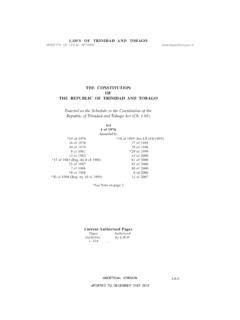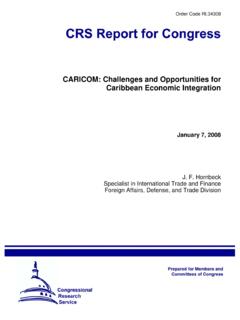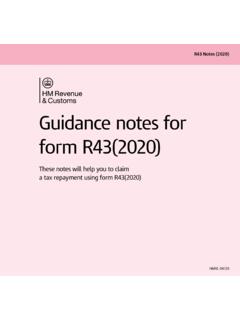Transcription of Telecommunications in Jamaica and the Caribbean
1 Spectrum Management Authority 1 Presented by Smith to the International Conference on Telecommunications Perspectives in the Americas and Europe, in Brazil, February 28 March 1, 2005 Opening Remarks Mr. Chairman, I thank you for that kind introduction, fellow panellists, distinguished guests, ladies and gentlemen. First, I wish to thank the University of Brasilia and ANATEL for inviting me to participate in this panel discussion at this most important International Conference. I will present the current scenario and perspectives with respect to Telecommunications in Jamaica and the wider Caribbean . I will first outline the present situation in Jamaica looking at the Pre-Liberalization and Post-Liberalization periods, then the present situation in some of the Caribbean islands and conclude with a brief look at the Technological, Regulatory and Political perspectives for the future.
2 Jamaica Macroeconomic Data Jamaica has a population of million with a Gross Domestic Product in 2003 of US$ Billion, which gives a per capita GDP of approximately US$3,900. The inflation rate for 2003 was Jamaica Pre-liberalization Before looking at the current situation, it may be useful to consider the environment immediately before liberalization. In 1988, the government privatized the state owned telephone company and issued five (5) licences to the new owners Cable and Wireless Jamaica , each for 25 years, expiring in 2013. However, by 1999, due to widespread dissatisfaction amongst the public based on the poor state of the country s Telecommunications services, the government embarked on a liberalization process and entered into negotiations with the incumbent to break its 25-year monopoly licence.
3 This resulted in the signing of a Heads of Agreement between the Government of Jamaica and Cable and Wireless, which essentially created the framework for the government to introduce competition to the sector on a phased basis. Telecommunications in Jamaica and the Caribbean Present Scenario and Perspectives Spectrum Management Authority Jamaica Phased Liberalization March 2000 signalled the commencement of Phase I of a three-part liberalization process. The main component of this phase was the introduction of competition to the cellular market. Two spectrum licences were issued by auction grossing US$ In addition the Telecommunications Act, 2000 was promulgated.
4 October 2001 was the beginning of Phase II with licences issued for Fixed Wireless services, introducing competition to the fixed line services market. Also, licences were issued to existing Subscriber TV Operators to facilitate their entry into the Internet Service business. Jamaica Phased Liberalization At March 2003, Jamaica attained full liberalization with competition introduced in its international voice services market. It is noteworthy, that, Jamaica achieved this milestone 10 years earlier than its commitment under the WTO Protocol. Current Status: Regulatory Framework In looking at the current status, I will first outline the existing Regulatory Framework.
5 There are four (4) separate bodies engaged in regulating the telecom sector. The Office of Utilities Regulation, OUR, is a multi-sector regulator, including telecom, electricity, water and transport. Its primary responsibilities are Telecommunications competition, economic regulation and consumer protection. It was established by the OUR Act, 1995, but uses as its principal legislation for the sector the Telecommunications Act, 2000. The Spectrum Management Authority, SMA, is responsible for the management of the radio frequency spectrum. It was created by the Telecommunications Act, 2000 but became operational in 2001.
6 Current Status- Regulatory Framework The third organization is the Broadcasting Commission, with the responsibility for broadcast content and technical regulation, except for spectrum. The other entity is the Fair Trading Commission, FTC, with responsibility for competition issues. They collaborate with the OUR on telecom matters. Current status - Operators Jamaica has two fixed-line services operators: The incumbent, Cable & Wireless Jamaica CWJ, with an estimated 450,000 lines; and Gotel, offering fixed wireless services, has less than 1% of that market. Spectrum Management Authority 3 The mobile market comprises: Digicel with 62% market share which is 1 Million subscribers.
7 GSM technology @ 900/1800 MHz; Cable & Wireless with 500,000 subscribers which is 31% of the market - GSM technology @ 1900 MHz as well as TDMA @ 800 MHz; and, Oceanic Digital Jamaica , the last operator to commence operations with 7% of the market with CDMA technology. A fourth licence was issued to AT&T in March 2004 but they are yet to commence operations. Current status Operators Internet service is provided to approximately 100,000 subscribers, with high speed access accounting for less than 10%. It is estimated that over 600,000 persons access internet service. Whereas, the government of Jamaica is satisfied with the universal nature of voice services (by virtue of the number of mobile subscribers), there are new policy initiatives being developed to achieve universal broadband data access.
8 There are nineteen (19) broadcast radio stations and three (3) free - to - air national television stations. Fifty-one (51) subscriber television operators are licensed on a regional basis. There is currently one company providing wireless subscriber television using the MMDS frequency band. Caribbean : Current State of Telecommunications Fourteen Caribbean countries are member states of the Caribbean Telecommunications Union, CTU. However, in the interest of time, I will present to you, in brief, the state of Telecommunications in five of the member states of the Organization of Eastern Caribbean States, OECS, as well as briefly look at Barbados and trinidad & tobago .
9 ORGANIZATION OF EASTERN Caribbean STATES The five OECS countries established the first known regional Telecommunications regulator known as the Eastern Caribbean Telecommunications Authority, ECTEL. They considered this approach as the most cost-effective strategy to provide regulation. Each member state has its own National Telecommunications Regulatory Commission. They achieved full liberalization of the sector as of May 2002. They have relatively small economies. The combined population of the five islands is 513,000 distributed as shown on the slide, St. Lucia has the largest population of 153,000 and St. Kitts & Nevis has 50,000. In terms of the teledensity the available data for 2003 indicates that for Fixed lines - St.
10 Kitts & Nevis (smallest population) has 47 lines per 100 inhabitants whereas St. Lucia is ranked number 2 with 33. For mobile subscribers - Dominica is ranked first with 12 subscribers per 100 inhabitants. Spectrum Management Authority 4 The main provider of fixed line service is Cable & Wireless. Since liberalization in 2002, new mobile operators have entered the market, a total of seventeen (17) licenses were issued by ECTEL. The providers of the cellular services in that region include Cable & Wireless, AT&T Wireless, Orange, Digicel and Cariglobe in the respective countries as shown below. 9 Dominica: AT&T, C&W, Orange 9 Grenada: AT&T, C&W, Digicel, GNP, TWTC 9 St.





